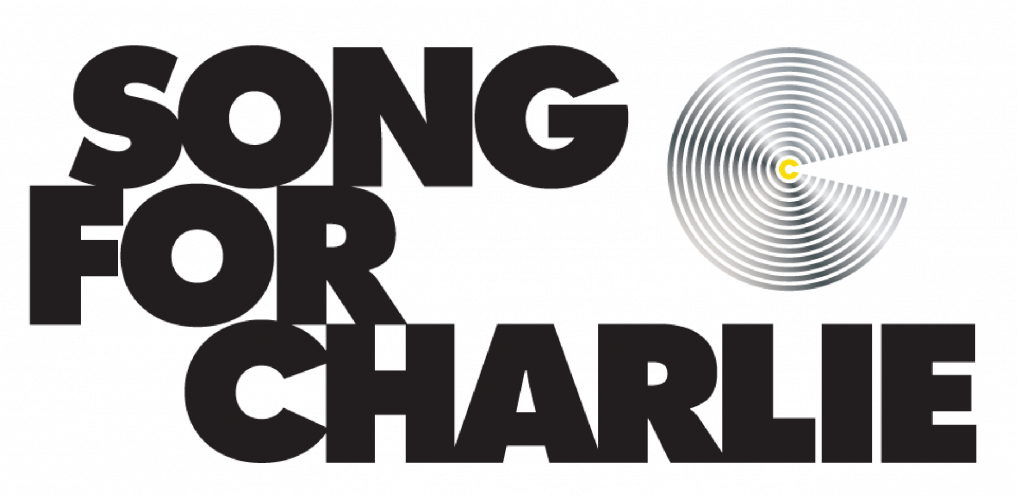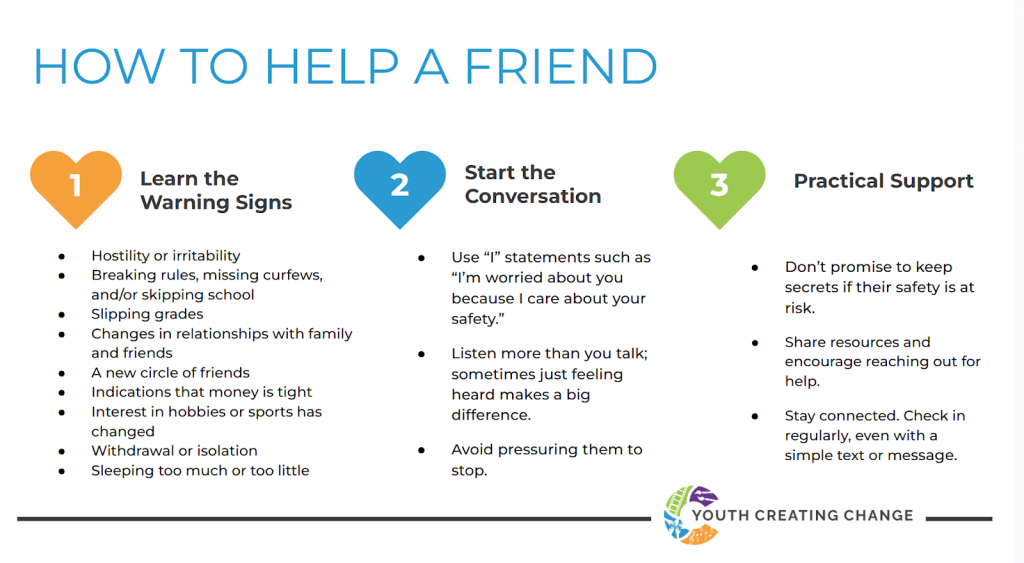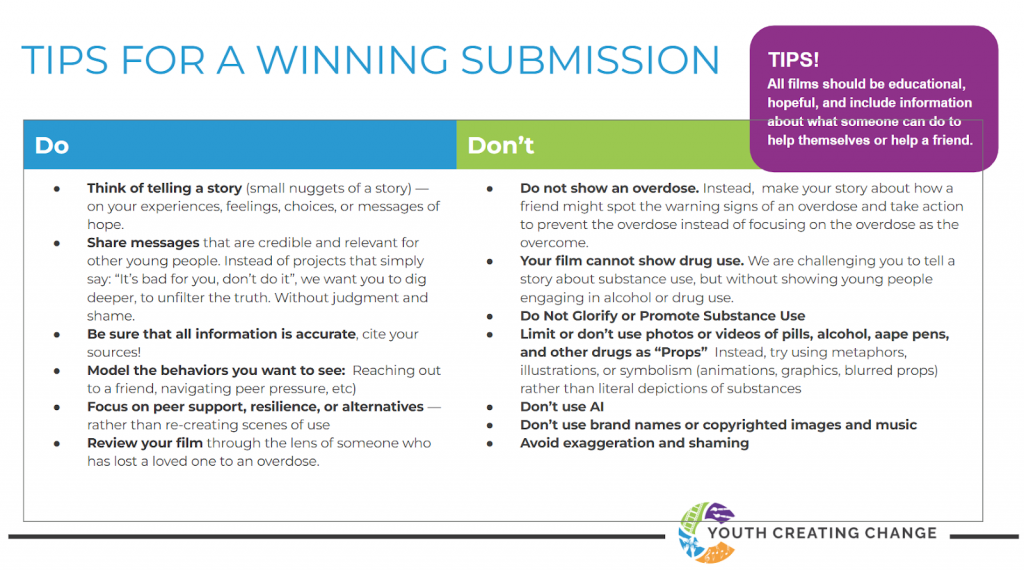SUBSTANCE USE
PREVENTION

Entering a film in this category provides you with an opportunity to explore the reasons behind why young people may (or may not) choose to use substances, talk about how to spot and respond to an overdose, and share healthy ways to cope with tough times and stress.
The film should not just talk about facts and statistics, but tell a compelling story that makes others feel and think differently about substance use, addiction, and the power of influence. Instead of projects that simply say: “It’s bad for you, don’t do it”, we want you to dig deeper, to unfilter the truth.
Creatively tell a story (small nuggets of a story) about your experiences, feelings, choices, or messages of hope. Model the action you want to see such as reaching out to a friend, showing healthy choices and coping strategies as alternatives to substance use, and how to access help.
CATEGORY
QUICK FACTS
SUBMISSION TOOLBOX
We are grateful for the support of Monterey County Public Health in launching our new Substance Use Category and Curriculum!


CATEGORY PARTNER:
Song for Charlie is a California-based non-profit that helps educate youth and families about the dangers of fake prescription pills made with fentanyl and other dangerous chemicals. Their support is made possible through their ongoing partnership with the California DHCS. Visit their website to get the facts, explore healthy coping skills, and learn how to spot and respond to an overdose.
Content Submission Criteria:
What Your Film Should Be About.
Here are a few examples of messages your film could communicate. But you are also welcome to come up with your own! Please be sure to also view the content guidelines and restrictions to ensure you submit a competitive film and avoid disqualification. For example, films cannot contain alcohol or other drug use, show an overdose, and will lose points for showing items, especially close-ups, of alcohol, pills, vape pens and more.
The Power of Influence: Many young people start using substances because friends or siblings introduce them to it. But what if friends and siblings used their power to influence those who look up to them towards the decision not to use substances? Create a PSA with a message to a friend, sibling, or even your younger self with the things you want them to think about before they make the choice to drink alcohol, vape, or use other substances.
- View this short 2 minute video “Choosing Wisely: Navigating the World of Natural and Artificial Highs” from Natural High to learn about the risks of artificial highs and their impact on the brain’s reward system.
- Check out these stories of athletes, musicians and others, like the story of Danyelle Wolf, World Champion Boxer.
- Share strategies to cope with peer pressure, such as staying true to your values, preparing an escape plan, and finding your group. Find tips on this website from Young Minds.
- Check out this 60-second Public Service Announcement “Living Your Best Life”
The Truth Unfiltered: Interview young people in your school or community about their thoughts on substance use, such as alcohol, vaping, opioids, cannabis, and other drugs. What do they believe? What do they wish they knew? Use real voices to uncover the “why” and “why not” young people choose to use substances such as alcohol, vapes, cannabis or others.
Here are some interesting resources and campaigns to find facts and inspiration:
- Decoded (Facts without Filter): https://decodedca.org/
- The Truth Initiative: https://truthinitiative.org/
- The Real Cost Campaign: https://therealcost.betobaccofree.hhs.gov/The Undo Campaign: www.undo.org
Get the Facts, Save a Life: You may have heard of fentanyl, but do you know enough to stay safe and protect your friends? Whether it’s pills, powder, or something shared at a party, fentanyl could be in it. Your film can share information about the dangers of fentanyl, how to spot and respond to an opioid overdose, and encourage young people to look out for their friends.
Winning PSAs in this category will use storytelling to deliver facts in a creative way, and without showing depictions of an overdose. You want your film to be educational and memorable, while also being mindful of how your PSA may make someone feel who has lost a loved one to an overdose.
- Be sure to check out the disqualification guidelines and visit “Additional Tips for a Winning Submission” for more examples
- Did you know? Calling 911 can save a life, and the Good Samaritan Law keeps you safe too. You won’t get in trouble for helping someone who is overdosing, even if you are under the influence or have a small amount of drugs in your possession.
Get the facts, explore healthy coping skills, and learn how to spot and respond to an overdose on the Song For Charlie website: SongforCharlie.org
“We often assume that someone who dies from drugs is different from us. They must have had big problems or an addiction or mental health issues. But that’s not true in Charlie’s case, nor in thousands of recent cases. In fact, the fastest growing category of ‘drug overdose’ victims is the occasional, recreational user of prescription pills. And that is because the pill supply has been poisoned – flooded with counterfeit fentapills.” Ed and Mary Ternan, Founders, Song for Charlie
Coping My Way: Coping strategies are actions we take to deal with stress, problems, or uncomfortable emotions and situations such as peer pressure to try substances. Deep breathing, eating well, moving our bodies, getting enough sleep, supportive relationships, spending time in nature, and caring for our mental health are ways that help us manage stress and bounce back when we face tough times or adversity. Unhealthy coping strategies can feel good in the moment or temporarily numb our pain, but can have long-term negative consequences.
Create a film that creatively tells a story about stress or adversity young people experience and how they cope. What barriers might be preventing a young person from using a healthy coping strategy instead of an unhealthy one such as substance use? Creatively explore what “coping my way” can look like.
- Pro Tip: Your film has to make the connection that substance use is an unhealthy way to cope and offer healthy alternatives.
- Additional resources: Learn “Skills over Pills”, “Build a “Pause Plan” to manage stress, and learn about healthy coping tips on the Live Beyond website.
- View this 60-second youth-created PSAs: “Bloom”
Your film can explore substance use and ways to cope through the lens of culture. Traditions, healing practices, and other support from our culture and community can positively impact our mental health. For example, studies have shown that individuals with strong connections to their cultural heritage such as traditional activities and spirituality, are more resilient to substance use. Feeling close to and supported by family and community can also provide a buffer against substance use.
How To Help A Friend: All submissions should include an action someone can take to help themselves or a friend!
- Remember: Substance use disorder is a health condition, and as dependence develops, control isn’t always a choice. Instead of trying to persuade someone to stop, it can be more helpful to show support by checking in, spending time together, and reminding them they’re not alone.

Language
Guidelines
All films have to consider language guidelines when messaging about this topic. Ignoring these guidelines can cause you to lose valuable points.
Use Person-First Language When Talking About People Who Use Drugs. The language that we use to talk about substance use is important. Stigmatizing language, whether used intentionally or unintentionally, can create a space that may be unwelcoming. Many common phrases used to talk about people who use drugs imply stigma, judgment, and shame.

Additional Resources:
- Words Matter: The Language of Addiction – https://drugfree.org/article/shouldnt-use-word-addict/
- Words Matter- Terms to Use and Avoid When Talking About Addiction – https://www.drugabuse.gov/nidamed-medical-health-professionals/health-professions-education/words-matter-terms-to-use-avoid-when-talking-about-addiction
Include Content And Images That Are Accurate, Nuanced, Respectful, And Promote a Positive Narrative. All films should be educational, hopeful, and include information about what someone can do to help themselves or help a friend. People struggling with addiction, as well as their families and loved ones, are often exposed to media portrayals of substance use, which can be both hurtful and helpful. Your film should provide accurate information and actions someone can take to help themselves or someone else. The film should be mindful of the diversity of individuals affected by substance use and not point at one group being more likely than another to use substances.
The pictures and videos you use to show substance use really matter. Certain images can make people feel judged, reinforce stereotypes, or even trigger cravings for someone in recovery. It’s also important not to make drugs look “cool” or exciting—for example, slow-motion shots of smoke, dramatic close-ups of pills, or stylized scenes with flashy music can glamorize substance use without meaning to. Choosing respectful, real, and supportive visuals helps tell the story without causing harm.
Choosing respectful, real, and supportive visuals helps tell the story without causing harm.
Animated
Films
While we do not have an Animated Short category this year, youth are invited to create animated or live-action films for the Through the Lens of Culture category. Animated films can be 30 or 60 seconds long. We refer to the Oxford English definition of animation: “The technique of photographing successive drawings or positions of puppets or models to create an illusion of movement when the film is shown as a sequence.”
All animation styles are allowed – 2D, 3D, stop motion, Lego, etc. All work must be original and created by youth. Use of premade templates or AI models is not permitted.
Disqualifying
Content
Your Film Cannot Contain or Portray Alcohol Or Other Drug Use. We are challenging you to tell a story about substance use, but without showing young people engaging in alcohol or drug use. In addition, you are strongly encouraged to not include images or video footage of pills, alcohol bottles, and similar content.
If you have any questions about this, contact us!
Be Creative And Cautious: Do Not Show An Overdose: If your film is about spotting the signs of an overdose or communicating the dangers of fentanyl, are there ways that you can tell this story without a depiction of an overdose? Can you make your story about how a friend might spot the warning signs of an overdose and take action to prevent the overdose instead of focusing on the overdose as the overcome? Consider how someone who has lost a friend or loved one to an overdose may be impacted by your film.
Here are a few examples:
- The Public Service Announcement (PSA) “No Drama No Help” was created by an advertising agency as part of the Over the Dose Vermont campaign.
- What we like: It tells a very creative story that feels like a real situation a group of friends could find themselves in. It brings home the point that signs of an overdose can be hard to spot. It doesn’t show young people drinking or using drugs, but uses a red cup as a prop.
- What we recommend: To score high points in our contest, the film would have ended with one of the friends taking action, such as checking on the friend and calling 911 if needed. One red cup on a table in the background would have sufficed as a prop.
- The PSA “Out of Body” was created by journalism students at the University of Kentucky.
- What we like: It tells a very creative and compelling story and has a clear call to action about not hesitating to administer Naloxone and to call 911. It also attempts to remove barriers to taking life saving action by including information about the Good Samaritan law.
- What we recommend: For our contest, this film would have been disqualified for prominent images of drug paraphernalia and the repeated depiction of the young person who overdosed. Although it makes the story feel very real, the details can be very traumatizing for someone who has lost a loved one to an overdose, almost making them relive the death of a loved one. We also want to avoid messaging that casts blame on the friends and family who were not able to prevent the overdose.
Do Not Glorify or Promote Substance Use. Your film should inspire action or change, but not in a way that promotes substance use as a solution or makes it seem like an appealing choice.
Research shows that visual depictions of drugs and drug use—even in prevention campaigns—can inadvertently normalize or glamorize the behavior. For teens, especially those who are still forming attitudes about substances, watching peers act out use may increase curiosity or reduce perceived risk. Public health researchers call this the “unintended modeling effect.”
Try this!
- Try using metaphors, illustrations, or symbolism (animations, graphics, blurred props) rather than literal depictions of substances.
- Incorporate role-playing resistance skills (saying no, seeking help) rather than re-enacting risky behaviors.
The Film Should Not Include Portrayals Of Suicide Deaths Or Attempts Or Items That Could Be Used in A Suicide Attempt.You might be thinking, this doesn’t apply to me since my film is about substance use, but it might. Increased use of substances is a warning sign of suicide, and pills are one way some people die by suicide. Showing items (also called means) that can be used in a suicide, can be very activating for people who have lost someone to suicide or who have considered suicide themselves. This matters because portraying actions related to suicide attempts and showing items someone might use for a suicide attempt, even in dramatization, can increase the chances of an attempt by someone who might be thinking about suicide and exposed to the film.
Your Film Cannot Contain Brand Names Or Copyrighted Images And Music. This includes being careful about the clothing your actors wear, and avoid clothing with large brand names. And although you are hopefully avoiding showing alcohol or drug use, be sure not to include any items with brand names visible.
Any elements in your film or art, including but not limited to music, audio, stills, video, supers, or other audiovisual materials used must:
- be entirely original, created and performed by the entrant and/or participants; or
- be in the public domain as creative work not protected by trademark or copyright, which can be used freely by anyone; or
- be purchased or released trademarked or released copyrighted elements, such as music, photographs, or logos.
Do Not Use AI. The use of AI to create any part of your film (including but not limited to: script, background, editing, etc.) is not permitted and will lead to the disqualification of your film. AI models are based on millions of images, including artists’ work, and therefore this is not considered to be original work. As artists, storytellers, and filmmakers, we ask that you act with honesty, integrity and respect as you create your films for this contest.
It is at the discretion of the program team to disqualify films that are deemed to have a potentially harmful message or image or that are not sensitive to racial, ethnic, religious, sexual orientation, and gender differences, with all individuals realistically and respectfully depicted.
Additional Tips for a
Winning Submission
- Think of telling a story (small nuggets of a story) — on your experiences, feelings, choices, or messages of hope.
- Share messages that are credible and relevant for other young people
- Empower the audience with information, rather than using shame
- Be sure that all information is accurate and avoid exaggeration, cite your sources!
- Model the behaviors you want to see: Reaching out to a friend, showing healthy choices and coping strategies, model how to navigate peer pressure, reaching out for help, etc.
- Focus on peer support, resilience, or alternatives — rather than re-creating scenes of use
- Review your film through the lens of someone who has lost a loved one to an overdose.

Limit Or Don’t Use Photos or Videos of Pills, Alcohol, Vape Pens, And Other Drugs as “Props”
Your film cannot include any images or videos of people drinking or using drugs. We are challenging you to tell a story about substance use, but without showing young people engaging in alcohol or drug use. In addition, you are strongly encouraged not to include images or video footage of pills, alcohol bottles and similar content. This could trigger cravings for someone in recovery or inadvertently glorify the use of substances. Although your film will not be outright disqualified, it might lose valuable points.
Research shows that visual depictions of drugs and drug use—even in prevention campaigns—can inadvertently normalize or glamorize the behavior. Even if the message is “don’t use,” imagery can increase awareness of how substances look, increase curiosity and reduce perceived risk.
Try this! Instead, try using metaphors, illustrations, or symbolism (animations, graphics, blurred props) rather than literal depictions of substances.
All films should be educational, hopeful, and include information about what someone can do to help themselves or help a friend.
Be sure to review our Substance Use Lesson plan for educational resources.
If you have any questions about this contact us!
